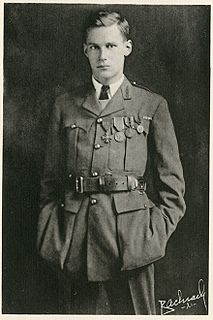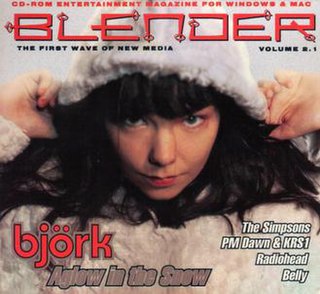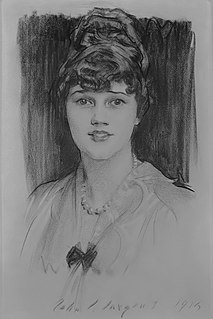
Miracleman, originally known as Marvelman, is a fictional superhero appearing in comic books first published by L. Miller & Son, Ltd. Created in 1954 by writer-artist Mick Anglo for publisher L. Miller & Son as a United Kingdom home-grown substitute for the American character Captain Marvel, the original series ran until 1963. It was revived in 1982 in a dark, post-modern reboot by writer Alan Moore, with later contributions by Neil Gaiman.

Harry Crosby was an American heir, World War I veteran, bon vivant, poet, and publisher who for some epitomized the Lost Generation in American literature. He was the son of one of the richest banking families in New England, a Boston Brahmin, and the nephew of Jane Norton Grew, the wife of financier J. P. Morgan, Jr. As such, he was heir to a portion of a substantial family fortune. He was a volunteer in the American Field Service during World War I, and later served in the U.S. Ambulance Corps. He narrowly escaped with his life.

Caresse Crosby was the first recipient of a patent for the modern bra, an American patron of the arts, publisher, and the "literary godmother to the Lost Generation of expatriate writers in Paris." She and her second husband, Harry Crosby, founded the Black Sun Press, which was instrumental in publishing some of the early works of many authors who would later become famous, among them Ernest Hemingway, Archibald MacLeish, Henry Miller, Anaïs Nin, Kay Boyle, Charles Bukowski, Hart Crane, and Robert Duncan.

Kay Boyle was an American novelist, short story writer, educator, and political activist. She was a Guggenheim Fellow and O. Henry Award winner.

transition was an experimental literary journal that featured surrealist, expressionist, and Dada art and artists. It was founded in 1927 by Maria McDonald and her husband Eugene Jolas and published in Paris. They were later assisted by editors Elliot Paul, Robert Sage, and James Johnson Sweeney.
PC World is a global computer magazine published monthly by IDG. Since 2013, it has been an online only publication.

Blender was an American music magazine that billed itself as "the ultimate guide to music and more". It was also known for sometimes steamy pictorials of celebrities. It compiled lists of albums, artists, and songs, including both "best of" and "worst of" lists. In each issue, there was a review of an artist's entire discography, with each album being analyzed in turn.

MIT Technology Review is a bimonthly magazine wholly owned by the Massachusetts Institute of Technology, and editorially independent of the university. It was founded in 1899 as The Technology Review, and was re-launched without "The" in its name on April 23, 1998 under then publisher R. Bruce Journey. In September 2005, it was changed, under its then editor-in-chief and publisher, Jason Pontin, to a form resembling the historical magazine.

The Diary of Anaïs Nin is the published version of Anaïs Nin's own private manuscript diary, which she began at age 11 in 1914 during a trip from Europe to New York with her mother and two brothers. Nin would later say she had begun the diary as a letter to her father, Cuban composer Joaquín Nin, who had abandoned the family a few years earlier.
The Black Sun Press was an English language press noted for publishing the early works of many modernist writers including Hart Crane, D. H. Lawrence, Archibald MacLeish, Ernest Hemingway, and Eugene Jolas. It enjoyed the greatest longevity among the several expatriate presses founded in Paris during the 1920s, publishing nearly three times as many titles as did Edward Titus under his Black Manikin Press. American expatriates living in Paris, Harry Crosby and his wife Caresse Crosby founded the press to publish their own work in April 1927 as Éditions Narcisse. They added to that in 1928 when they printed a limited edition of 300 numbered copies of "The Fall of the House of Usher" by Edgar Allan Poe. They enjoyed the reception their initial work received, and decided to expand the press to serve other authors, renaming the company the Black Sun Press, following on Harry's obsession on the symbolism of the sun.

The Escaped Cock is a short novel by D. H. Lawrence that he originally wrote in two parts and published in 1929. Lawrence wrote the first part in 1927 after visiting some Etruscan tombs with his friend Earl Brewster, a trip that encouraged the author to reflect upon death and myths of resurrection. "The original short story version of Part I of the novel appeared in The Forum magazine, February 1928." Lawrence added the second part in 1928 during a stay in Gstaad, Switzerland.

The Reliques of Ancient English Poetry is a collection of ballads and popular songs collected by Bishop Thomas Percy and published in 1765.

The League of Extraordinary Gentlemen: Black Dossier is an original graphic novel in the comic book series The League of Extraordinary Gentlemen, written by Alan Moore and illustrated by Kevin O'Neill. It was the last volume of the series to be published by DC Comics. Although the third book to be published, it was not intended to be the third volume in the series. Moore has stated that it was intended to be "a sort of ingenious sourcebook", and not a regular volume.
The Calico Print was a newspaper, established in 1882 and published during the heyday of the silver mining camp of Calico, California prior to 1902. The Calico Print was also the name of a monthly, later bi-monthly, periodical of the mid-20th century, and contained "Tales and trails of the desert West."

Walter Van Rensselaer Berry was an American lawyer, diplomat, Francophile, and friend of several great writers. He was also an American tennis player active in the late 19th century.
Richard Rogers Peabody grew up as a member of the upper class in Boston, Massachusetts. He attended Groton, where his grandfather was headmaster, and later enrolled at Harvard as had many of his family before him. He married Polly Jacob, the daughter of another blue-blooded Boston family with whom he had two children. He served as a captain during World War I in the American Expeditionary Force.
Erik Rodgers is an American film writer, director, and producer who currently resides in Los Angeles, CA. He is one of the founding members of String And A Can Productions, Inc.
Cary Selden Rodman was a prolific American writer of poetry, plays and prose, political commentary, art criticism, Latin American and Caribbean history, biography and travel writing—publishing a book almost every year of his adult life, he also co-edited Common Sense magazine.

Nat. Brut is an American literary magazine founded in 2012 by Anna Ploegh and Andrew Ridker. The magazine contains artwork, prose, and poetry by a set of diverse artists and is publicized both online and in print. The most recent issue is Issue 14, which features a folio by incarcerated writers in New Jersey entitled "Inside Voices," as well as poetry, fiction, essay, and visual art.

Constance Crowninshield Coolidge, was a Boston Brahmin, socialite, heiress and a long-term American expatriate living in Paris. She had the pedigree of the most elite Boston Brahmim; she was a descendant of the Adams, Amory, Coolidge, Copley, Crowninshield, and Peabody families. She was a distant relative of Calvin Coolidge.














